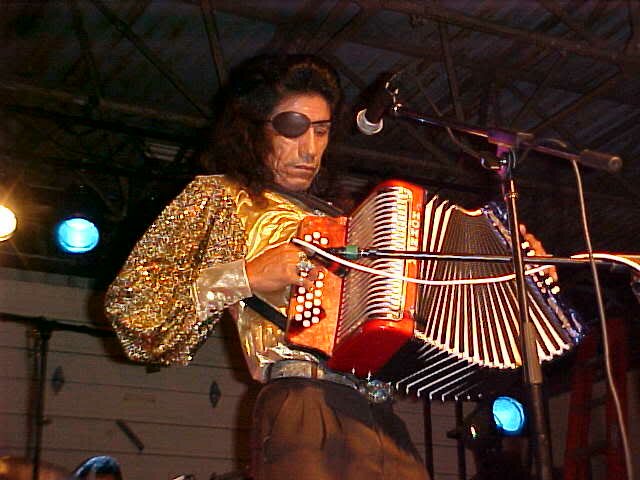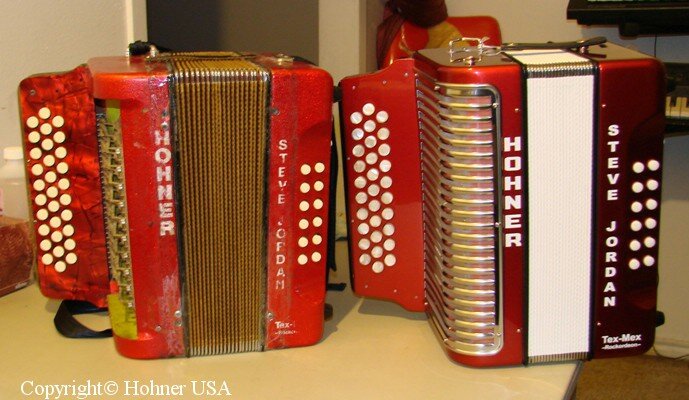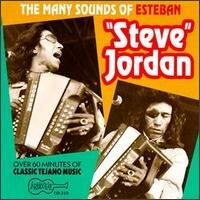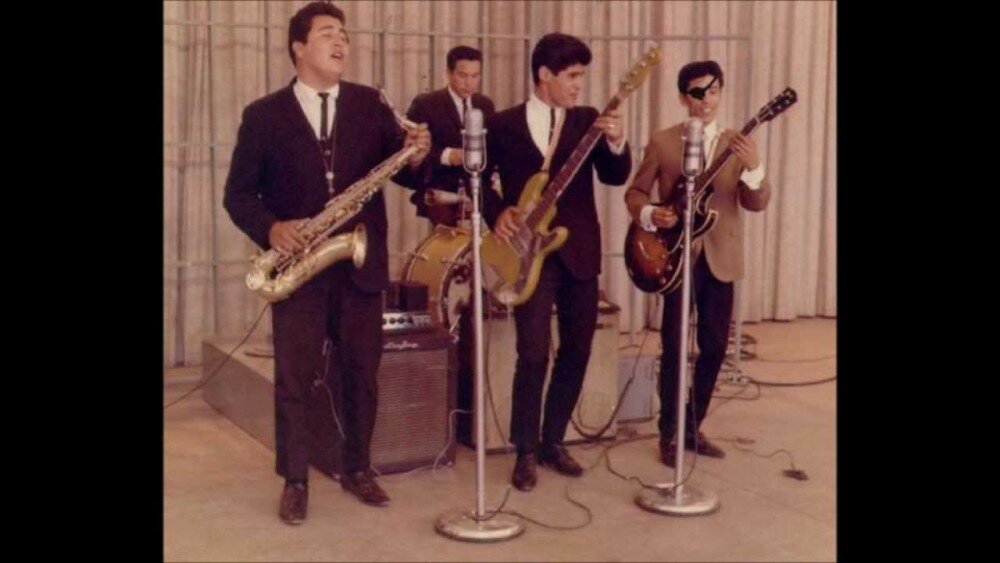
Steve “Esteban” Jordan at the 2004 Conjunto Festival in San Antonio. Photo by Karlos Landin.
When he walked onstage at the 20th anniversary of the Tejano Conjunto Festival in San Antonio’s Rosedale Park in May 2002, Steve Jordan was resplendent in a purple jumpsuit with gold buccaneer sleeves. But what stood out most was how frail the 62-year-old accordion legend looked. Like a skeleton clinging to its last layer of skin, Jordan appeared so gaunt that his right eye patch seemed to cover half his face. A stray strand of his jet black mane stuck to his lips, giving this cholo pirate an even more eery look as he strapped on a red diatonic button accordion bearing his name.
Then came the smile, that ear-to-ear endorsement of the moment. To other entertainers, a grin is a given. But on the mouth of a pioneer prone to bitterness, who rarely plays in public these days, the upturned corners meant something.
It’s not often that an enigma comes to life before your eyes, so when “Estay-bon Hor-don,” as he was introduced, took off on a jazzy tangent to start his set, the audience of about 2,000 erupted. Conjunto purists have not always been fans of Jordan’s attempts to modernize a style of music that peaked in popularity in the ’50s, and he’s not exactly big with the Tejano crowd, which prefers its frontmen to wear cowboy hats and dance around. But on this night the factions of fans blended together to welcome home the nororious troubled genius. When he punctuated the perfect night with his trademark girlie yelp, the cowboys in their white straw hats raised their cans of light beer and the women brushed against the up beat.
“Voy a cantáerles un corrído muy al albla” (“I’m going to sing you a great corrido”) he vocalized on a traditional Mexican folk song that he would “Jordanize” with cat-quick button runs and a skronking solo closer to be-bop than Tex-Mex. “Esta es la historia de un pachuco muy rocote,” he sang in an unharnessed voice.
This is the story of one badass pachuco.
JUNE 2002: The way you interview Steve Jordan is to drive to San Antonio and just show up at his door in the house in the back yard of another house on the far West side. Appointments don’t mean much to the man who’s never owned a watch. He’s been known to take off at the drop of a Hohner on impromptu deep sea fishing and casino gambling vacations off South Padre.
But on this day you’re lucky. It’s four in the afternoon and Jordan’s home, but he’s still sleeping. “He was up all night recording,” his 19-year-old son Steve says. “Give him another hour or two.” A polite and soft-spoken kid, Steve III (he has an older half-brother also named Steve Jordan) gives a tour of the studio that dominates the living room. The only TV is tuned to a surveillance camera outside. The only stereo is a big wooden console number on top of which several Ampex reel-to-reel tapes are stacked. The famous red “Steve Jordan Tex-Mex Rockordeon” is on the floor next to a chair. There are musical instruments everywhere — guitars, drums, saxophones, timbales and two or three other button accordions. Jordan can play them all with the virtuoso skill another man named Jordan once displayed on the basketball court.
“How do you like my little set-up here?” asks the man himself, emerging from a bedroom less than half an hour since the knock on his front door. “You meet my 280 musicians? Right here, man, in my synthesizer. Best musicians I ever jammed with, bro, cause they all play like me.” There’s that exaggerated snicker and the slap on the back. Mr. Jordan’s wearing sunglasses instead of the patch that earned him the nickname “El Parche.”
You don’t need to ask a question to get him to take off on any given subject in his hipster growl. “I hate digital, man,” he says pointing to his ancient reel-to-reel decks. “Music is not this,” he says chopping the air like the vertical coding on CDs. “It’s like this,” he says, rolling his hand in circles.
Steve Jordan doesn’t do interviews, he holds court. He tells stories, recounts old gigs and goes off on riffs, jumping from an explanation of why he used to own a hearse (“I didn’t want my first ride in one to be in the back”) to his assessment of other accordion players (“That dumb cowboy’s pretty good, but he can’t play with me,” he says of one.)
At the mention of a recent article in the San Antonio Express-News which, while acknowledging Jordan’s genius, includes allegations of drug use, brings out a trace of the notorious temper. “I’ll take a dude outside and whip his ass if he disrespects me,” he says. “Society can’t touch me, man. Never has. I never went to school, never been trained how to act. I’m an animal, bro.”
“I’m not afraid to die,” he says, lifting his shirt to show a scar that runs from his navel to just below his breast plate. “I’ve already been dead, bro.”
Moments later, Jordan is back to telling funny stories about the early years on the road. If you’re going to keep up with Steve Jordan, you can’t dwell on anything he says or does. “I remember the first time I ever heard of acid, LSD. It was 1964, bro, and the stuff was legal,” he says. “We had just finished playing — it was somewhere in California — and some dude asks the band if we want to do some acid. I said, ‘Sure, I’ll try anything,’ and started rolling up my sleeve. But the dude said, ‘You don’t shoot it, you eat it.’ ” Jordan goes on to describe LSD hallucinations so horrifying that he says he swore off acid forever. “At one point, I asked my bass player, ‘What’s that funny-looking thing? What does it do?’ and he said ‘That’s your accordion, man.’ That was it for me. When I couldn’t recognize my accordion, that was way too fucked up.”
He’s been called “the Jimi Hendrix of the accordion” since the late ’60s, when he introduced psychedelic phase shifters to an instrument aligned with “The Lawrence Welk Show.” He’s also been compared to Charlie Parker — in both talent and temperament, but Jordan doesn’t agree. “Charlie Parker just played jazz. I play jazz, but I also play rock, country, salsa, mariachi, cumbias — you name it.”
These days, however, Jordan is more like Brian Wilson during his obsessive Smile days. During the past eight years, when he snipped his barfly wings and evolved into a studio parrot, Jordan has recorded more than 100 new tracks, stuff he says is 20 years ahead of its time. It’s a heavily layered sound, with Jordan running his guitar notes through a pair of Roland synthesizers to create everything from cellos and violins to otherworldly horn sections. The music of Steve Jordan’s mind is full and offbeat. But despite its inherent trippiness, there’s an unmistakable melodic thrust to the new material, which sounds like ’60s soul one minute and a loco polka the next. “I’ve always been way ahead of everybody else, but this stuff is in a whole other galaxy, man.” He doesn’t trust a record company to put it out, just as he doesn’t let managers, booking agents or anybody else in the music industry touch his art. He hasn’t released a new album in 12 years.
“The big man upstairs is teaching me patience,” Jordan says. “That’s something I’ve never had before. Maybe the plan now is for me to lay low and let everybody else catch up a little. But I tell ya, I’m not slowing down, bro. I still kick ass every day.”
Jordan gave up the bottle after he fell during his 53rd birthday party and broke his arm. When he turned 54, his friends chipped in and surprised him with a $2,000 synthesizer he’d been pining for. “They were gonna sign for it and I was going to make the payments,” Jordan says, “but then at the store they had a little meeting and decided against it. I was hurt, man. I had no idea that they had planned to surprise me with it a few days later.” He slaps five to Efraim Palacios, the head chipper-inner who has stopped by to tell Jordan about a possible gig in Saginaw, Mich., a city with a huge population of homesick Mexican and Texan migrant workers. Palacios, who sells business communication systems during the day and drops in on Jordan at night, is more a responsible friend than manager. “We created a monster,” the preppily-dressed Palacious says of the synthesizer that led to Jordan’s single-minded compulsion to record. Jordan stopped listening to other musicians and just concentrated on his own sound. In December, Jordan recorded a Christmas song so he’d have something to listen to during the holidays.
By his own estimation, Steve Jordan is 125 years old. “When I was a little kid, I couldn’t work in the fields. I couldn’t pick cotton, so I stayed behind in the camp with all the people who were too old to work,” he says. “When I was 7 years old, I was 70 in my mind.”
He began life in the Rio Grande Valley town of Elsa in 1938 with a fire in his eyes. Moments after he was born, a midwife gave him contaminated eye drops which caused Jordan to lose all sight in his right eye and most of it in the left. He was he runt of 15 children born to migrant worker parents, but Steve could play every instrument he got his little hands around. His earliest memory is of playing the harmonica as a toddler. He moved on to guitar, bass and drums. One night in a labor camp outside of Lubbock, 7-year-old Jordan was playing guitar and heard a sweet accordion sound coming from the shack next door. “I stuck my head out and he stuck his head out and we decided to play together.” he says. And that’s how Jordan met a teen-aged Valerio Longoria, who would go on to join Santiago Jimenez Sr. (Flaco’s dad) and Narciso Martinez in the holy trinity of conjunto acordeonístas. “I had seen people playing the accordion before, but never so close or so good,” says Jordan.
The accordion was invented in Berlin in1822 as the orchestra for the common people and when Jordan squeezed one for the first time and heard the richness of sounds, he knew he had found his instrument. In just three weeks he was accomplished enough to play for tips in the cantinas. Asked when he started thinking about making a living as a musician, he says it was as soon as he made his first dollar that night in El Campo 55 years ago. “School didn’t make sense to me,” says the first-grade dropout. “The whole idea is to learn some way to make money, but I already knew how to make money, man.” As a teen-ager in the early ’50s, Jordan saw a demand for dance bands, so he pulled four brothers out of the fields and taught each one their musical role. “That’s how I learned all those instruments,” he says. “When I’d show someone in my band what to play, I was also teaching myself.”
In 1958, Steve settled in San Jose, Calif., and married the great singer Virginia Martinez, who would join him on vocals on several regional hits in the traditional ranchera and polka styles. He was faster, flashier, more versatile than the other accordion players right from the start, but Jordan really opened up, both literally and musically, in 1973 after he was knifed by a stranger whose motive is still unknown. “Getting stabbed really turned me around,” he says of the parking lot assault outside a bar in Roswell, N.M. “I realized that it was time to stop fucking around and just get down all the sounds in my head. Don’t hold back, because life is short.”
You can hear the innovations evolve on the essential Many Sounds of Estéban ‘Steve’ Jordan (Arhoolie), which opens with nine tracks recorded in 1963 with Martinez and ends with an assortment from the ’70s.
During his ’73 hospitalization and year-long recuperation, Jordan often passed the time taking his equipment apart and putting it back together. For years he’d been retuning his accordions by filing the reeds inside, but when he studied the inner workings of an echoplex and perfected various effects, he took conjunto music to a new level. The “invisible genius of Texas accordion music” he was called in a 1992 Option magazine profile by Ben Ratliff, now a jazz critic for the New York Times. The beloved Flaco Jimenez had become the ambassador of conjunto music, but it’s Jordan, who keeps progressing, even if it means shaking a few fans with every zig and zag.
“He really blew the doors open to what the accordion could do,” says Brave Combo’s Carl Finch, who helped compile The Return of El Parche, a 1988 reissue of ’70s Jordan recordings for Rounder. “He’s just an all-round genius and on top of that he’s got this bulletproof mystigue.”
But as with many innovators, Jordan hasn’t achieved the success of many of his imitators. His groundbreaking singles for Corpus Christi-based Hacienda Records in the ’70s rarely sold more than 1000 copies and nobody can remember the last time he had a radio hit. He’s an international dude stuck in a Chicano world, as he told one critic, an expressionist expected to conform to the limitations of a diatonic instrument designed to play in only three keys.
Accordion players and manufacturers all over the world know about him, however, and Jordan says one of his proudest moments was the hero’s welcome he received when he visited the Hohner plant in West Germany 11 years ago. The day after he appeared at a Berlin jazz festival, the company presented Jordan with an accordion they customized to his specifications, including almost flat buttons for faster finger action. “The factory tour was a trip, man, because I always like to see how things are produced. Then I played for all the assembly line workers, and you could see their jaws drop,” he says. “I showed ’em what they were making.”
There are no wrong notes, only players who don’t know what to do with them, Jordan says. Sometimes he’ll hit a “wonk” when you’re expecting a “wink,” but in his jazz player’s consciousness, it all makes sense. He doesn’t know where it comes from, this inspiration that makes him happy and drives him crazy. “I don’t wanna wake up until I die,” he says. Making music is putting yourself in a trance that tunes out the world, often to the dismay of wives and bill collectors.

Steve Jordan was also an accomplished guitarist, who claims to have influenced Carlos Santana.
“I don’t give a damn about the audience,” he continues. “I could be playing for five people or 5,000 — it doesn’t make a difference. I’m still gonna kick ass. And if you ain’t gonna play because there’s nobody there, then get the fuck out of my band.”
Jordan’s wicked perfectionist streak is such that he once hauled his own PA system to a taping of “Austin City Limits.” Although he flatly stated that he wouldn’t go on without his own speakers, he finally relented when it was pointed out that the “ACL” system was set up for television taping and not some Tejano bar. Jordan has also been known to be brutal with club sound engineers. “I’m sorry, but white guys just can’t mix Mexican music. They always want to put the emphasis on the beat,” he says, imitating a bass drum. “But we like the up beat.”
Jordan says reports that he can be a fiery bandleader are justified, but there’s no problem with his current band. “They’re like little pieces of me,” he says of 17-year-old bassist Richard Jordan and the 19-year-old guitarist Steve 3. “They’ve been playing only 11 months, and they get what I’m saying the first time.”
The father didn’t really know his sons when they were growing up. There were occasional Christmas visits and a fishing trip here and there, but for the most part he wasn’t an active participant in their upbringing. He didn’t get along with their mother, his second and, he vows, final wife. Then, one day about two years ago, she dropped them off with the near-stranger with the eye patch, saying she couldn’t control them anymore. Suddenly, Jordan’s simple life — record, sleep, eat, record — wasn’t so simple. He signed the custody papers.
At the time Jordan was without a band, and therefore without an income (he says he’s never received a penny in royalties from the nearly 50 albums he’s released in his career). When a lucrative gig was offered in Houston, Steve said he’d take it. He had three weeks to teach his sons, who were more into sports and Nintendo than music, how to play 30 songs, but they did the show and have barely stopped playing since. “These boys, they keep me young,” the proud father says. “They never complain. They never want to stop.”
Steve suddenly stops talking and raises a hand for silence as his version of “Harlem Nocturne” plays in the background. The jazz standard, which Steve spent more than a week producing, starts with a lushly layered orchestra conjuring every shade of the night. “Can you dig it, man?” he asks when his accordion starts into the melancholy melody. “All that sound from this little brown box,” he says, tapping an old Hohner on the floor with his foot. He touches his chest where the buttons would be, swaying his head as if he’s lost in a dream.
“Man, what am I doing here, living in the back of some other dude’s house, with my kids sleeping on the floor?” he asks, cutting into the ethereal moment. “Ask yourself that, bro. But this is why,” he says, gesturing back to the speakers, where his accordion is flitting all around the melody like a bouquet of fireflies. “This,” he says tapping the air.
What a gift it is, the ability to blow your own mind. For Estéban “Steve” Jordan that’ll have to do for now.
Postscript
“I just want to get this shit on the streets, man. I wanna see everybody flip. Then I can die and head on to the next place.”
Jordan lived another eight years after our encounter in 2002, succumbing to liver cancer at age 71 on Aug. 13, 2010. But he hasn’t had the big posthumous career he envisioned. Of his nine albums purportedly in the can, Jordan released only one album- a year before he died. The gambler may have released Carta Espiritual (“Letter To God”) to better his odds in the unknown. But nobody flipped. Maybe he’s still ahead of his time or, maybe, as ex-wife Virginia Martinez said in 2005, the unreleased recordings were a way to attract people who gave Jordan money to see these masterpieces released. “Steve’s a fisherman,” she said, “and those recordings are his bait.” Martinez said she invested $35,000 in the project years ago, but nothing came of it.
Austin fans held a big tribute benefit for Jordan at the H&H Ballroom near Kyle in 2008. The fans turned out and so did the musicians, with Little Joe Hernandez coming down from Temple to do just a song or two and ending up onstage with Esteban for a set that just about tore the ballroom down. I stood with Jordan at the side of the stage just before he went on and remarked that it was an impressive turnout, with more than 1,000 fans paying a big cover, and his response was “I’ve seen bigger.” But you could tell he was genuinely touched by the outpouring. And he and his sons in Rio Jordan played for more than an hour and a half. Esteban Jordan wasn’t there to take a bow. He was there to kick your ass. One more time.